The SS America and the SS United States were designed by William Francis Gibbs, America’s greatest naval architect.
SS America SS United States
United States passenger liners were at a competitive disadvantage during Prohibition from 1919 through its repeal in 1933. American ships could not serve liquor even when they were on the high seas. Foreign vessels only had to shutter their bars when they were within the twelve mile territorial limit of the United States.
The United States also lacked a fast and modern passenger liner to compete with Britain’s Queen Mary, France’s Normandie, Italy’s Rex, and Germany’s Bremen and Europa. During the 1930s, these five liners held the Blue Riband, the unofficial accolade given to a passenger liner for the fastest crossing of the Atlantic either eastbound or westbound. Holding the Blue Riband was a matter of national pride and immense prestige for the ship that translated into increased passenger bookings.
Foreign ocean liners had construction and often operating subsidies from their governments. The United States Maritime Commission had no desire to build a super liner and was willing to subsidize only medium-sized economical liners. Gibbs designed the SS America as a sleek, modern alternative to the Queen Mary that he regarded as stodgy with serious design flaws as well as being a fire hazard.
The SS America was built by Newport News Shipbuilding and Dry Dock Company just before the outbreak of World War II. Her keel was laid on August 22, 1938. She was launched on August 31, 1939, and was christened by First Lady Eleanor Roosevelt. Its construction costs were $1.2 million.

The America was 723 feet long, 93 feet wide, and weighed 26,454 gross tons. She could carry 1,202 passengers in three classes (543 in cabin class, 418 in tourist class, and 241 in third class) plus 643 crew members. In comparison, Queen Mary was 1,019 feet long, 118 feet wide, and weighed 80,774 gross tons. Queen Mary could carry 2,140 passengers and 1,100 crew members.
The décor of the Queen Mary resembled an English country estate, while the America’s interiors were described as “restrained luxury” making use of stainless steel, ceramics, and synthetic fabrics. Gibbs was fanatical about fire aboard ships; his design made use of Marinite, a particle board infused with asbestos for fireproof interior partitions.
SS America entered service on April 16, 1940, and was operated by the United States Lines. Due to the threat from German submarines, America did not make trans-Atlantic crossings but operated as a cruise ship in the Caribbean. On May 28, 1941, the Navy requisitioned America and converted her to a troopship: the USS West Point. The West Point could carry 7,678 troops. During World War II, West Point carried over 350,000 troops into both the European and Pacific Theaters.
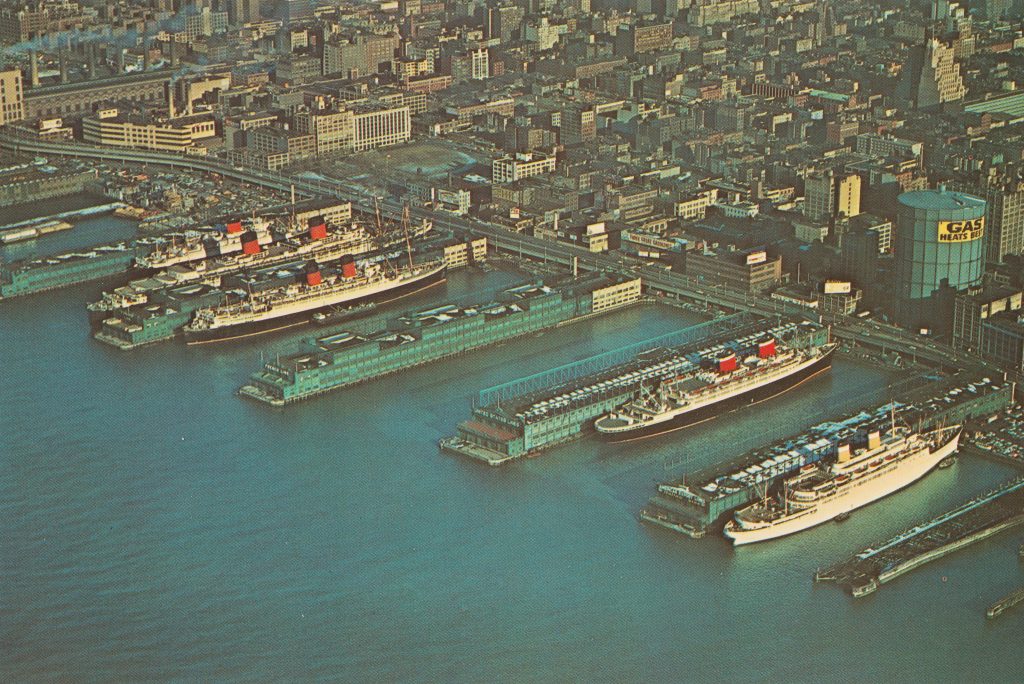
SS America returned to service as an ocean liner in 1946. Facing stiff competition from trans-Atlantic jet flights, the America was taken out of service by United States Lines in November 1964 and sold to the Chandris Group, a Greek shipping concern. Renamed Australis, she carried emigrants from Europe to Australia until 1978. From 1979 until 1993, she went through a succession of owners who failed to maintain the ship. In January 1994, while under tow to Thailand for conversion to a hotel ship, she ran aground off Fuerteventura in the Canary Islands and was almost immediately ripped apart by powerful waves. She sank in March 2007.
In the late 1940s, United States Lines needed a running mate for the America to compete with the Queen Mary and Queen Elizabeth, both of which were working on a schedule of weekly sailings. Additionally, the U.S. military needed the capability to quickly transport a division (14,400 troops) in case war broke out. (During her service as a troopship, the Queen Mary carried over 15,000 troops on one voyage.) These two needs would be met by building a super liner. Gibbs finally got his chance to design the super liner he dreamt of since 1916.
Newport News Shipbuilding and Dry Dock Company also built the United States. She cost $71.8 million. Her keel was laid on February 8, 1950; she was launched and christened on June 23, 1951. The U.S. government covered 70% of her construction cost and also provided operating subsidies during her career. Reportedly, the United States could be converted to a troopship in 48 hours.
SS United States is 990 feet long, 101.5 feet wide, and weighed 53,329 gross tons. Her narrow beam enabled her to transit the Panama Canal. During her trials, she achieved a speed of 38.32 knots although her normal speed was 30 knots. It was claimed the United States could reach 43 knots. Like naval warships, her machinery spaces were compartmentalized to ensure the ship could continue operating in case of damage. Her capacity was 1,972 passengers with 1,044 crew members. Her mid-century modern décor was designed by Dorothy Marckwald and Anne Urquhart who had also designed the interiors of the America. Like the America, the United States used Marinite panels for partitions to stop the spread of fire. All the drapes, carpets, and furniture were fireproof.
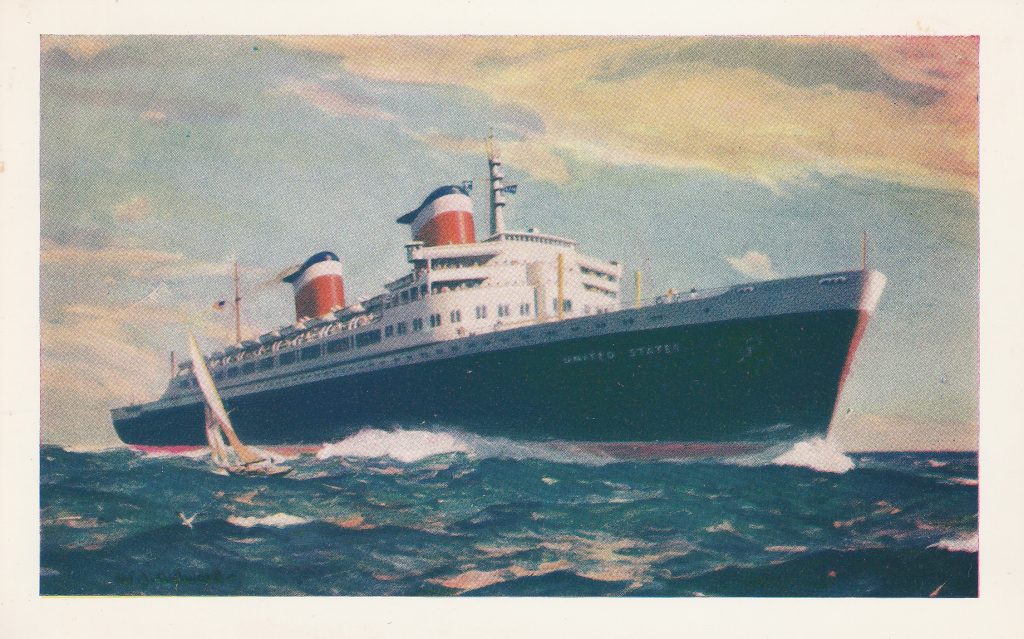
SS United States began her maiden voyage on July 3, 1952, and arrived in Southampton on July 7. On her first voyage, the United States broke the eastbound transatlantic speed record (measured from Ambrose lightship off New York Harbor to Bishop’s Rock off Cornwall in the U.K.), beating the previous record crossing by more than ten hours held by the Queen Mary for fourteen years. On her return trip, she wrested the record for fastest westbound crossing also from the Queen Mary. She reportedly reached 34 knots during the two voyages. The United States still holds the coveted Blue Riband. No ocean liner has ever surpassed her speed in crossing the Atlantic.
Left: The United States off lower Manhattan in the late 1950s or early
1960s. Right: The America and the United States passing in the Hudson River.
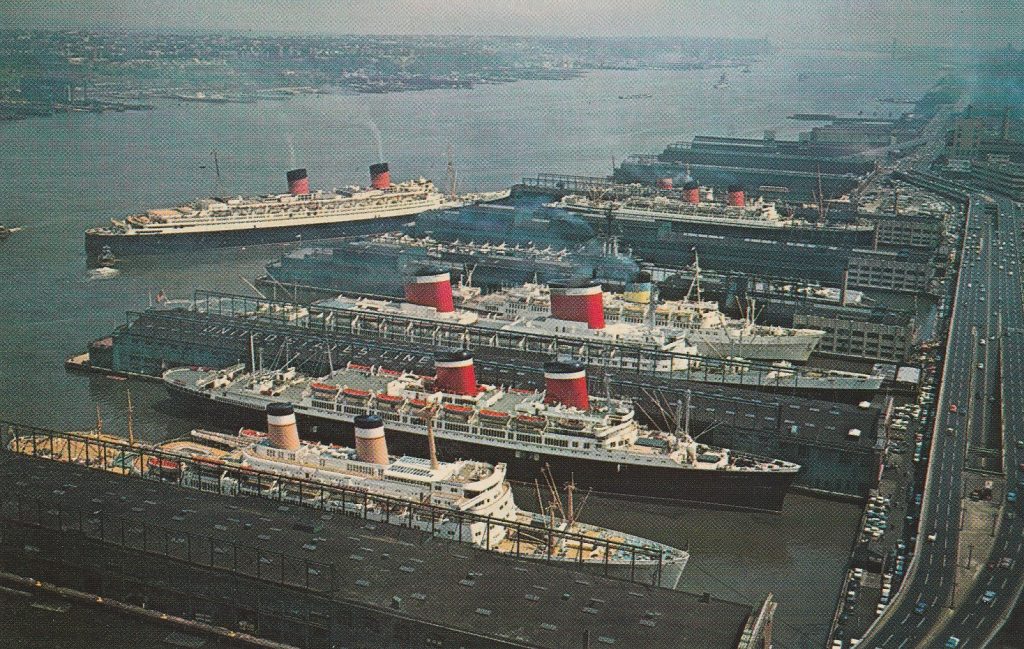
An early 1960s postcard shows SS Queen Elizabeth being guided to her berth by tugboats. Already docked (L-R) are the Independence, America, United States, Olympia, USS Intrepid (a retired Navy aircraft carrier), Mauretania, and Sylvania.
The United States soon became the most popular liner crossing the Atlantic and attracted a celebrity clientele. In the 1960s, passenger bookings declined as all the Atlantic liners faced stiff competition from jet aircraft. The United States made its last Atlantic crossing in November 1969 and was laid up after the federal government cancelled its annual operating subsidy. During her seventeen-year career, the United States had made 800 transatlantic crossings (400 round trips), steamed 2,772,840 nautical miles, and carried 1,025,691 passengers.
When word came that she was being taken out of service, the United States was at Newport News Shipbuilding and Dry Dock for her annual overhaul. In June 1970, the United States was towed across Hampton Roads to a berth at Norfolk International Terminals where she remained until March 1989 when she was towed back to Newport News to be berthed at the CSX coal pier.
She was towed to Ukraine in 1992 for asbestos removal, then back to the U.S. in 1996 after the plan to convert her to a cruise ship failed. The United States has been berthed in South Philadelphia near the airport since her return.
Okaloosa County, Florida (in the northwest panhandle) has acquired the United States with a plan to sink her as an artificial reef (the same as was done to the aircraft carrier USS Oriskany off Pensacola in May 2006). Towing of the United States from Philadelphia to Mobile, Alabama to be prepared for sinking is scheduled to begin this month.
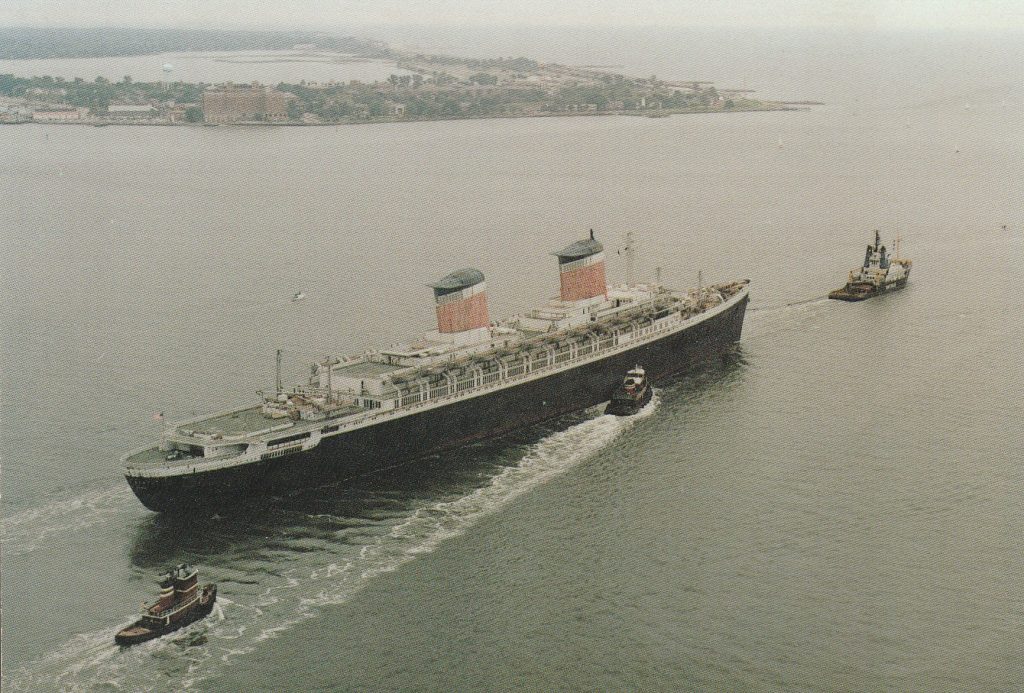
The last postcard produced of the United States. She passes Fort Monroe in Hampton, Virginia under tow to Sevastopol, Ukraine for asbestos removal on June 4, 1992. The United States first passed Old Point Comfort during her builder’s trials forty years earlier on May 4, 1952. Twenty-two years of neglect have taken their toll on a ship that was once the symbol of American maritime supremacy.
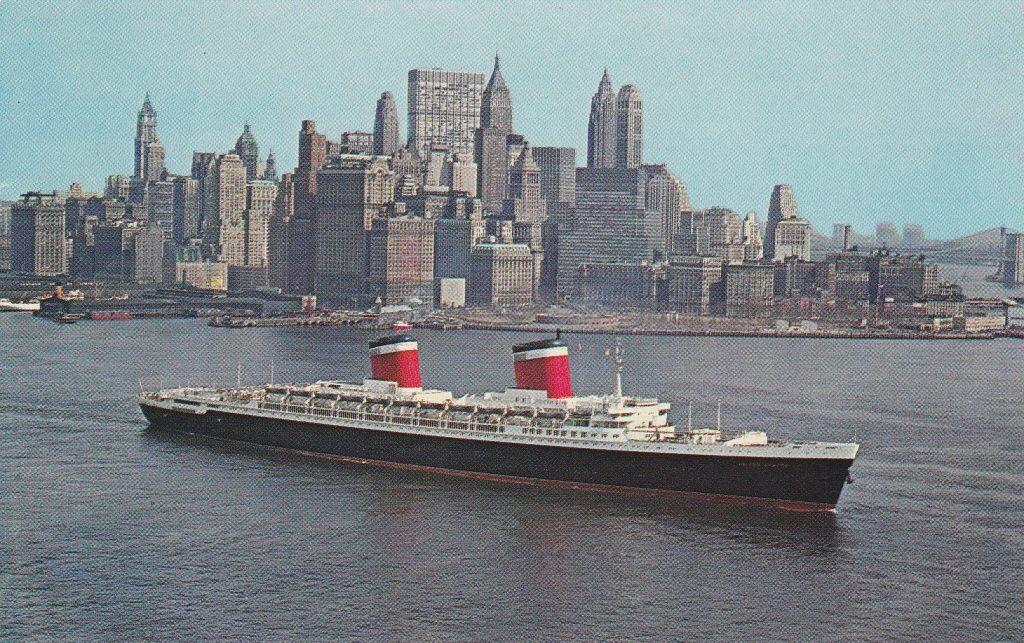

I am confused. In the description of Mr. Hennelly, it is stated that “he has collected postcards since his 1960s boyhood”, then states he also collects foreign cards “after receiving a gift from a 1930s honeymoon tour in Europe “. How can he be a boy in the 1960s and on a honeymoon in the 1930s?
Karen,
A neighbor in the 1960’s gave me the postcards she bought during her European honeymoon in the mid-1930’s. She also gave another group of postcards she bought during an auto tour with her two sons of the Western United Sates in the early 1950’s. Her kind gift was the nucleus of my early collection. I always think of her when I come across one of the postcards she gave me. I’m sorry it was a little muddled in my author bio.
Dan Hennelly
Thank you very much for the clarification.
Loved this article! I crossed on the QE2 in 2018 going from Southampton to Brooklyn.
Highly recommend the experience!
What an interesting read! Passenger liners used to be both practical and elegant. This article really helped me understand how American came onto the scene with two outstanding passenger liners, and how those ships played a role in our military. Thanks for sharing!
I enjoyed the article. I feel an affinity for the SS United States. During the time the United States was docked at Norfolk International Terminals, my brothers, friends and I made several trips by canoe to view the ship. I understand the nostalgia for the days of travel by transatlantic steamer. The ships were symbols of a nation’s technological prowess and served a serious purpose. In contrast, modern cruise ships seem to be floating hotels hosting endless buffets.
It’s kind of sad that the United States had such a short cruising life, but at least the ship will survive as a home for marine life.